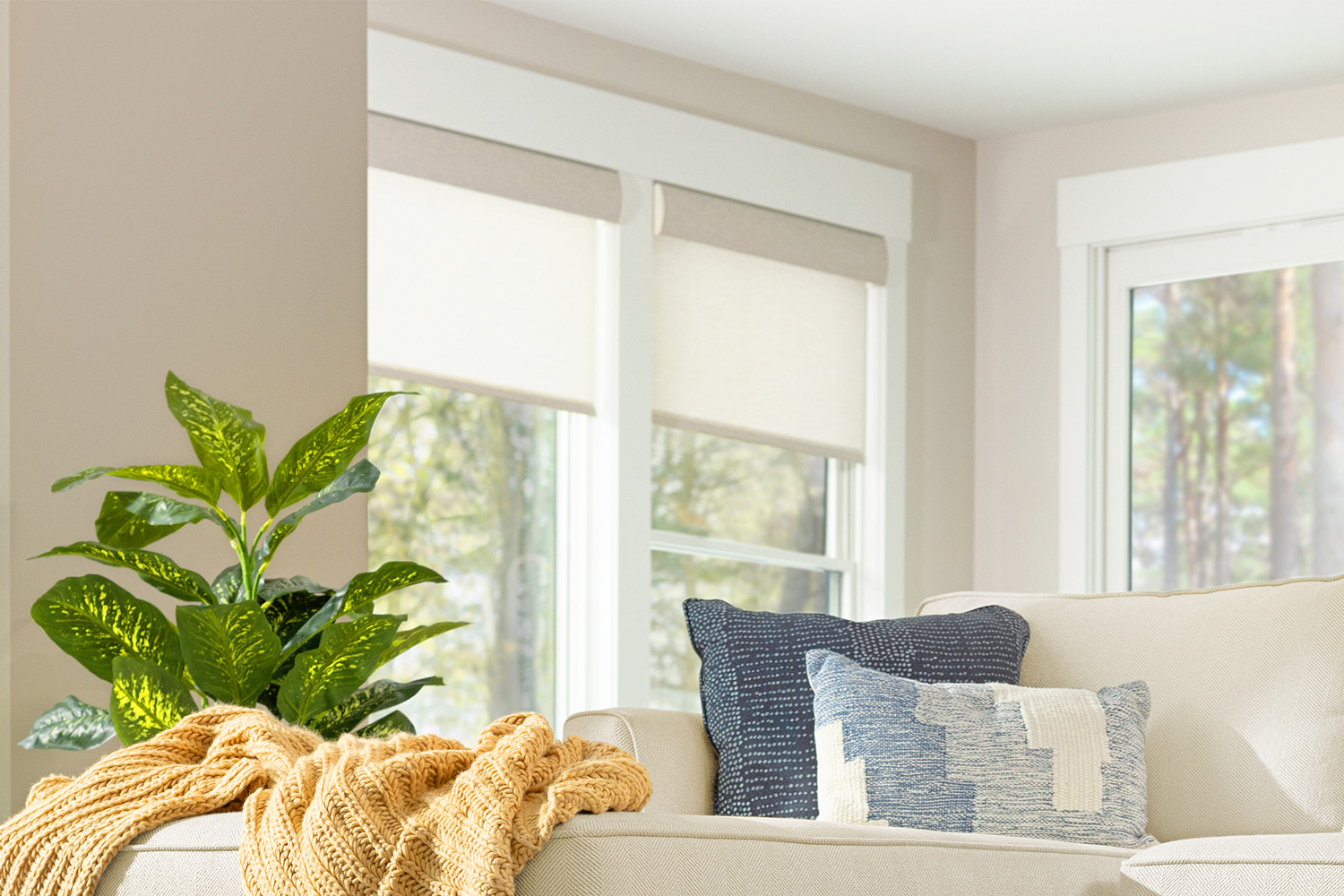How to Clean Window Blinds and Other Window Coverings
Dusty window blinds can immediately spoil a stunning view – and send particles into the air each time you open or close them. But cleaning window blinds and drapes isn’t always straightforward.
Different types of blinds and window shades require specific cleaning techniques. Using tools like a stick vacuum and handheld steamer can make the process more efficient and keep dust from spreading around the room.
This expert guide provides step-by-step instructions for cleaning Venetian, vertical, roller, wooden, and fabric blinds and drapes, with recommendations for the best tools and techniques for each.

Understanding different types of window blinds
Venetian blinds
Venetian blinds have horizontal slats and are often made of aluminum, plastic, or wood. Because the slats are horizontal, they collect dust and dirt quickly, making regular cleaning important.
Vertical blinds
Vertical blinds consist of long, hanging slats, often made of vinyl, fabric, or aluminum. They are commonly found on large windows and sliding glass doors and require a combination of dusting and deep cleaning.
Roller blinds
Roller blinds are made of a single sheet of fabric or vinyl that rolls up around a cylindrical roller when not in use – usually at the top of the window frame. They are less prone to dust accumulation but can show stains.
Wooden blinds
Made from real or faux wood, these blinds or shutters add elegance but need careful cleaning to avoid water damage. Because the slats are horizontal, they easy collect dust.
Fabric blinds
Fabric blinds, such as Roman shades or pleated blinds, are prone to dust and stains. Cleaning requires gentle handling and sometimes steam cleaning.
Fabric drapes
Fabric curtains and drapes can collect dust in the folds. If they are pulled open and closed by hand, grime can build up in the spots they are constantly handled.
General tips for cleaning blinds
Safety precautions
- Remove blinds from mounting brackets for thorough cleaning when necessary.
- Examine the type of material your window coverings are made of and clean a small test area if you have any concerns about the effectiveness or safety of your technique.
- Avoid using steam or excess water on wooden blinds to prevent warping.
How to clean metal and plastic blinds
Cleaning metal or plastic blinds, such as Venetian blinds, vertical blinds, or plastic “wood-look” blinds can be a daunting task. After all, there may be dozens of individual slats to clean. But with the right approach, getting gunk off can be quick and hassle-free.
The durable materials used in these window coverings were designed to withstand regular cleaning, making them easy to maintain, including keeping dust, grime, and dander allergens at bay. Here’s how to clean metal and plastic blinds.
Materials needed
- Stick vacuum, such as the PowerClean® FurGuard™ 280W Stick Vac
- Microfiber cloth
Dust metal and plastic blinds
Step 1: Use a stick vacuum to remove dust and debris
Start by tilting your blinds so they are fully closed and you can see all the slats. Then, attach the brush tool to your stick vacuum. If you use the PowerClean® FurGuard™ 280W Stick Vac you will detach the hand vac from the foot of the machine and attach the Dusting Brush.
Gently run the brush along the slats to remove loose dust. For vertical blinds, hold the base of each slat to stabilize it while vacuuming from top to bottom. For all styles of blinds, once you are done vacuuming one side of the slats, tilt the slats the opposite way and vacuum the other side to ensure a thorough clean.
Step 2: Dust with a microfiber cloth
Follow up by running over the blinds with a microfiber cloth for any remaining dust, focusing on tight corners, edges, and cord holes. As with the vacuum, be sure to dust both sides of the slats.
Deep clean metal and plastic blinds
While regular dusting helps prevent dust and grime buildup, monthly deep cleaning keeps your blinds in great condition.
Materials needed
- Stick vacuum, such as the PowerClean® FurGuard™ 280W Stick Vac
- Microfiber cloth
- Handheld steam cleaner, like Steam Shot™ OmniReach™ Handheld Steam Cleaner & Sanitizer
Step 1: Vacuum and dust the blinds
Follow the steps above, using the PowerClean® FurGuard™ 280W Stick Vac and a microfiber towel to remove dust and debris from both sides of the slats.
Step 2: Loosen grime with steam cleaner
If you notice stuck-on dirt or residue, use a handheld steam cleaner, such as the Steam Shot™ OmniReach™ Handheld Steam Cleaner & Sanitizer, to loosen and break up the grime so it can be removed. (Want inspiration? Check out this video of @michaelabrown7 steam cleaning horizontal blinds back to their original state.)
If you don’t have a handheld steam cleaner, try wiping the slats with a slightly damp sponge.
Step 3: Hand dry the blinds
Dry immediately after cleaning, using a microfiber cloth to prevent water spots or – for metal blinds – the appearance of rust. Be sure to dry both sides of the blinds. To help any extra moisture quickly wick away, keep the blinds tilted open to increase air flow and consider turning on a fan.
How to clean fabric blinds

Fabric blinds add style to a room, but the material can attract dust and stains over time. Fabric blinds require a gentler touch than metal or plastic blinds, but they are still easy to clean and preserve their texture and color. Here, we’ll discuss the best way to clean fabric blinds, from routine dusting to deeper cleaning.
Dust fabric blinds
From honeycomb blinds to flat window panels and vertical blinds, many fabric blinds can withstand dusting with a vacuum. Use a light touch – do not bend or crease the material as you clean. If your blinds appear too delicate to vacuum, dust with a microfiber cloth instead.
Materials needed
- Stick vacuum, such as the PowerClean® FurGuard™ 280W Stick Vac
- Microfiber cloth
Step 1: Close the blinds
Position the blinds so the fabric panels lie flat and you can see most of the material you want to clean.
Step 2: Use a stick vacuum
Convert your PowerClean® FurGuard™ 280W Stick Vac into a hand vac and attach the Dusting Brush.
Starting at the top, gently run the brush along the blinds to remove loose dust. For vertical blinds, hold the base of each slat while vacuuming from top to bottom. For horizontal fabric blinds, cover the full width then work down.
If possible, vacuum both sides.
Step 3: Spot dust with a microfiber cloth
For areas the vacuum might have missed, use a microfiber cloth to pick up any leftover dust or lint.
Spot clean fabric blinds
Some fabric blinds can be spot cleaned with liquid, but others may be too delicate for a deep clean. Make sure to check the manufacturer’s tag to ensure your fabric window coverings can be cleaned with water or cleaning formula. The more paper-like the blinds, the less likely they will withstand wet cleaning.
Materials needed
- Damp sponge or towel
- Cleaning formula, such as a spray upholstery cleaner
Step 1: Test clean a discrete area
If your blinds appear to be made of a durable fabric and the manufacturer’s instructions say they can be cleaned with liquid, test wiping down a discrete area with a sponge or cloth damp with clean water.
For deep stains, you may want to add a little cleaning formula, such as a spray upholstery cleaner, to your sponge or cloth.
Be cautious that some fabrics can hold onto “water spots” – which often appear as a ring where the material that has been wet takes on a different color than the dry fabric. If spotting occurs, you may want to weigh the cost of getting the material clean versus creating a water spot in the process.
Step 2: Clean the spot
If your test clean didn’t harm the blinds, try the same technique on the stained area.
How to clean roller blinds

Roller blinds offer a sleek, minimalist look and are often made from materials like vinyl, polyester, or a combination of synthetic fabrics that are treated to resist dust and moisture. Unlike slatted blinds, roller blinds are made of a single, continuous sheet of material, so they hang completely vertical and collect dust and stains differently.
How to dust roller blinds
Materials needed
- Hand vacuum, such as the 3-in-1 PowerClean® FurGuard™ 280W Stick Vac
- Microfiber cloth
Step 1: Fully extend the blinds
Start by fully extending the blinds, rolling them all the way down so the full surface is exposed for easy cleaning.
Step 2: Clean with a vacuum
Use a handheld vacuum – such as the 3-in-1 PowerClean® FurGuard™ 280W Stick Vac, which can be used with a dusting brush attachment. Gently run the brush over the surface from top to bottom. Repeat on the backside for a thorough clean.
Step 3: Dust with a microfiber cloth
If any dust or lint particles remain, use a dry microfiber cloth to gently dust the roller blinds. Move downward in smooth, vertical strokes to remove dust without smearing it.
Deep cleaning roller blinds
Roller blinds made from more durable materials, such as vinyl, may be able to withstand deeper cleaning with a liquid solution. Be sure to check your manufacturer instructions before attempting to clean your blinds with anything wet. For best results, you may need to remove your blinds from the windows and lay them flat during cleaning.
Materials needed
- Spray stain remover designed for use on the roller blind material
- Clean cloth or sponge
Step 1: Dust with stick vacuum
Follow the above instructions to remove all dust and loose particles from the roller blinds.
Step 2: Test clean an inconspicuous area
Before applying water or a cleaning product to your roller blinds, spray or dab a small amount onto an inconspicuous area. Wait a few moments to ensure it doesn’t discolor or damage the material.
Step 3: Spot clean as needed
Use a soft sponge or cloth to gently blot or wipe the stained areas with water or a cleanser designed for the material. Avoid soaking the fabric, as excess moisture can damage certain materials or affect the blind’s shape.
Step 4: Allow to dry
Keep the blinds open until they are fully dry. This will allow air to circulate. To speed up drying, turn on a fan, open a window, or run your HVAC system.
How to clean wooden blinds
If your blinds are made of plastic molded to look like wood, follow the instructions for cleaning plastic blinds detailed earlier in the article.

Wooden blinds require special care to maintain their natural beauty and prevent damage. Unlike other blind materials, such as metal or plastic, wood is sensitive to moisture and harsh cleaning products, so it’s important to use gentle cleaning methods to protect the finish while effectively removing dust and dirt.
Dry cleaning wooden blinds
Materials needed
- Stick vacuum with a brush attachment, such as the PowerClean® FurGuard™ 280W Stick Vac
- Microfiber cloth
Step 1: Close the blinds
Prepare your wooden blinds for cleaning by closing them so the slats lie flat, making them easier to clean.
Step 2: Stick vacuum with brush attachment
Use your PowerClean® FurGuard™ stick vacuum and its soft brush attachment on a low setting to carefully remove dust without scratching the wood. Rotate the slats in the opposite direction and repeat the dusting process to clean both sides thoroughly.
Step 3: Dust with a microfiber cloth
Use a microfiber cloth and gently wipe each slat, dusting from one end to the other, to fully remove any remaining particles.
Maintaining the finish of wooden blinds
Materials needed
- Stick vacuum with a soft brush attacment
- Wood cleaner
- Microfiber cloth
Step 1: Apply wood cleaner
After you’ve dusted the blinds, use a wood-specific cleaner and a microfiber cloth to clean and preserve the finish of the wood. Clean both sides for best results.
Step 2: Wipe away excess with clean cloth
Dry the blinds, using a dry cloth to wipe away any remaining moisture.
How to clean fabric curtains and drapes

Curtains and drapes bring polish to a window, but the material often hangs onto dust and stains. Before you attempt to clean your drapes, review the manufacturer’s instructions. Some store bought window coverings can be machine washed. But others, such as custom drapery, require a more delicate touch, requiring dusting and spot treatment.
If your drapes are clean but wrinkled, you can steam out the wrinkles with a with the fabric attachment.
Cleaning drapes and curtains
Materials needed
- Stick vacuum, such as the PowerClean® FurGuard™ 280W Stick Vac
- Brush or upholstery tool
- Mild detergent
- Microfiber cloth
- Soft sponge or clean towel
- Spray bottle
- Washing machine
Step 1: Close the curtains
Fully close the curtains, eliminating as many contours in the material as possible.
Step 2: Vacuum the curtains
Select an appropriate tool for your handheld vacuum. If you are using the PowerClean® FurGuard™ 280W Stick Vac, you can choose between the dusting brush or the FurFinder™ upholstery tool. Vacuum from top to bottom, cleaning both sides of the drapes.
Step 3: Spot clean if needed cloth
If your curtains can’t be machine washed but show signs of staining, you can try spot treating with a cleanser recommended by the manufacturer, such as an upholstery cleaner. Before you embark on a full cleaning, test an inconspicuous area to ensure the material won’t discolor or hold onto water spots.
Maintenance tips to keep blinds clean for longer
Dust regularly
Once or twice a month, use a stick vacuum or duster on your window coverings to prevent dust buildup.
Keep your windows closed
Yes, fresh air is good. But opening the windows for extended periods of time can let in extra pollen and other particles that can settle on your window coverings.
Avoid moisture on wood blinds
Keep wooden blinds dry at all times, as water can cause warping, staining, or peeling of the finish. Never use wet cloths, sprays, or steam cleaners on wood blinds.
Frequently asked questions
What is the easiest way to clean dirty blinds?
The easiest way to clean dirty blinds is to dust them regularly with a microfiber cloth, duster, or vacuum with a brush attachment. For deeper cleaning, some window coverings may be able to be spot cleaned. Check the manufacturer’s instructions before you attempt any wet cleaning.
How often should I clean my blinds?
It’s recommended to lightly dust your blinds every week or two. Deep cleaning, when applicable, can be done every month or two, or as needed.
Can I clean my blinds without taking them down?
Yes, most blinds can be cleaned while still hanging, allowing you to dust, vacuum, or spot clean while the blinds are still in place. However, for a deeper clean, in some instances it may be easier to remove the blinds and lie them down flat to clean both sides.
How do I remove stubborn stains from fabric blinds?
For fabric blinds with stubborn stains, you may be able to use a cleaning formula to remove the stains. Always read the manufacturer’s instructions first and test in an inconspicuous area to ensure the spray stain remover doesn’t damage the fabric of your blinds.